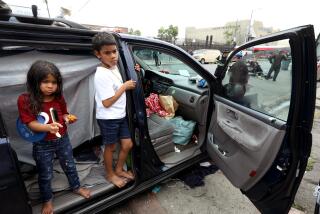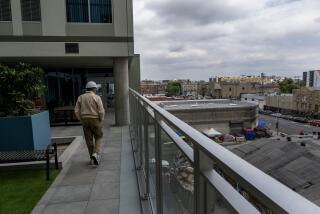His spotlight illuminates lives of the homeless
Eighteen years ago, when John Malpede established his theater company, Los Angeles Poverty Department, on skid row, the neighborhood belonged largely to homeless men. Now, 36% of the 6,000 to 8,000 people sleeping on the streets each night are women and children -- an increase, ironically, that mirrors the influx of high-end loft-buyers and redevelopers.
Malpedeâs goal with his theater for the homeless is to give people without a forum the chance to be heard, so itâs not surprising that his troupeâs latest effort, to premiere this week, reflects this new reality. Like most of the companyâs scripts, the one for âLa Llorona: Weeping Women on Skid Rowâ was created by the actors. It was based on a Mexican legend, but its subtext is that on any given day, according to a recent study by the Los Angeles Community Action Network and the Downtown Womenâs Action Coalition, there are only 12 nonemergency beds, at two downtown shelters, available to mothers with children.
âI donât have a license as a minister or a social worker. As an artist, you license yourself,â Malpede said the other day while sitting outside the James M. Wood Community Center on skid row. His mischievous eyes suggested at one moment a sweet, impish naif and at the next a resilient old owl.
âThe important thing is to keep things as confused as possible,â he said. âArt is about messing up the categories so you can catch people by surprise and expand their awareness.â
But to be a catalyst for expression, Malpede, like many others in the 30-year-old community arts movement, must enter territory not his own and impose his expertise on a group. And this work raises complex issues. âLa Lloronaâ addresses the fact that the presence of children on skid row has contributed to a traditional, nuclear-family feeling on the streets and that the homeless are responding, in part, by increasingly wanting to sink roots.
In the past, Los Angeles Poverty Department, known as LAPD, has helped skid rowâs inhabitants to organize. Now itâs stepping into a crisis, and while Malpede has his own hope for these people -- permanent housing -- he has to be careful not to shape their views to match his.
This is the community artistsâ dilemma, and it raises the question: Whatâs the distinction between community art practice and social or welfare work?
The question doesnât appear to trouble the 58-year-old Malpede, who is also a performance artist and got his start in New York after doing graduate work in philosophy at Columbia.
âPeople who ask that probably donât even know what social work or what art is,â he said.
Although Malpede is internationally respected in the burgeoning community arts field as a pioneer whose ambitious projects have influenced cultural and social policy, he doesnât pretend to have all the answers.
âEveryone always wants to define community art and pat it on the back, flatten it to one dimension,â he said. âBut multidimensionality is our reality. We canât be easily pinned down.â
For Malpedeâs company, that has meant a life on the edge and often in obscurity. In the not-too-distant past, the company had $1,000 in the bank for a solid year. Asked about the troupeâs budgetary high, Malpede said he believed it was $100,000. Sometimes he pays himself a salary, sometimes not. Currently, he and his wife, Netherlands-born Henriette Brouwers, live in a friendâs house.
Still, the company -- among the first of its kind in the nation, and one that has toured to Detroit, Seattle, Houston and elsewhere -- has never gone completely dark, and its actors have always been paid, making them technically professionals. Why does Malpede do it?
âThe great equalizer is, weâre all going to die,â he said. âThat normalizes us. If you live on skid row, skid row is a low-income neighborhood, and LAPD is deadly serious about participating in creating it as a normative neighborhood.â
The groupâs social successes are measurable. Nearly half the 14-member âLa Lloronaâ cast has been in its productions before, and several hold important positions in skid rowâs orderly, daytime village life, including Rickey Mantley and Chas Jackson. Mantley is editor in chief of the 5-year-old Community Connection, a free bimonthly street newspaper with a circulation of 5,000. Jackson is an ardent tenant advisory council representative for the nonprofit Single Room Occupancy Housing Corp. and among those responsible for more security guards having been hired to patrol the area. Both men have e-mail addresses, phones and places they call âhome,â and within LAPD they are not unusual.
Asked to explain how Malpede and the troupe have made a difference, Jackson responded: âPeople thank us after our shows, saying they relate to our stories and donât feel so alone. When so many things are telling you that you donât count and ought to be âdisappeared,â LAPD helps you take pride.â
It was Jackson, Mantley and another troupe veteran, known as Alexander the Poet, who suggested to Malpede that the troupe do something about the sharp rise in their neighborhoodâs women-with-children population and the tendency of some vocal loft-owners and police downtown to brand all homeless as undesirable.
Malpede responded by asking Brouwers to revive and revise her earlier production of âLa Llorona.â Trained in the movement discipline of mimes Etienne Decroux and former L.A. resident Daniel Stein, Brouwers instantly recognized the potential. The Mexican legend concerns a mother who kills her children and herself, and is doomed to wander the Earth looking for them.
Brouwers opened casting to all comers. Nobody was turned away; nobody ever is from the troupe. She started with movement exercises, and gradually the women and men began to tell what had happened to bring them to skid row and separate them from their children.
âI kept running to the bathroom to cry,â said one woman, Sashae Siatui. âIt was horrible reliving my life.â
But Brouwers discovered that when Siatui sang, she had a voice that could make hairs stand on end, and that another woman, April Shell, was an extraordinary dancer. So Brouwers appointed Siatui the âLa Lloronaâ singer who would explicate the myth, and Shell its dancer. She asked neighborhood resident Michael Ray Tucker to create an original score on his keyboard, with Alexander the Poet contributing some lyrics. The rest of the cast was directed to shape their life histories into significant vignettes, led by narrator Ibrahim Saba.
âI learned that what we are really doing is building a language together,â said Brouwers.
The idea of activists and audience members learning from the community through a mutual exchange is central to LAPD.
âTypically, a person thinks change will only happen when âeveryone sees it my way,â â Malpede said. âThe point is, itâs actually the opposite -- you have to find a way to work with people. You canât ask anyone to do anything you are not willing to do yourself, because change is about exchange.â
On Sept. 25, Malpede will be honored by the Cornerstone Theater Company at its fourth annual Bridge Awards at the Autry Museum of Western Heritage. According to the rules of his complex world, he must be getting back some of what he has given: recognition.
*
âLa Llorona: Weeping Women on Skid Rowâ
Where: Central City Church of the Nazarene, 6th Street and San Pedro, downtown
When: Thursday and Sunday, 6:30 p.m.
Price: Free
Contact: (213) 413-1077
Also
Where: Balch Auditorium, 1030 Columbia Ave., Scripps College, Claremont
When: Nov. 14, 7:30 p.m.
Price: Free
Contact: (909) 607-3541
More to Read
Sign up for Essential California
The most important California stories and recommendations in your inbox every morning.
You may occasionally receive promotional content from the Los Angeles Times.










